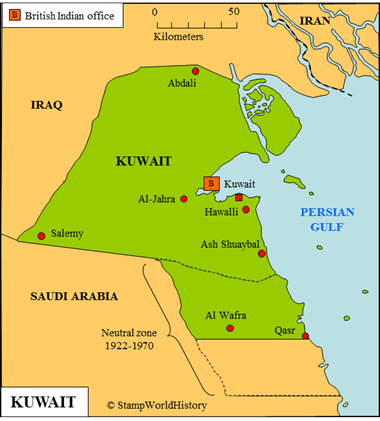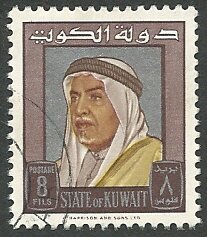الكويت

Kuwait
British protectorate

Kuwait
Emirate
Quick reference
General issues: British protectorate 1923-1961, Emirate 1961-Present
Country name on general issues: Kuwait
Currency: 1 Rupee = 16 Anna 1923-1957, 1 Rupee = 100 Naye Paise 1957-1961, 1 Dinar = 1000 Fils 1961-Present
Population: 50 000 in 1920, 3 369 000 in 2013
Political history Kuwait
Kuwait is located in the Middle East, western Asia. In the 19th century Kuwait is an emirate under Turkish sovereignty. Officially part of the Ottoman vilayet[1]Province of Basra, the emirate manages to maintain a substantial amount of self government. Towards the end of the 19th century British influence in Kuwait increases. When the Ottoman Empire sides with the Central Powers[2]Germany, Austria-Hungary and their allies. in WWI, the British invade the Ottoman Empire in the Middle East. As a result, Kuwait, in 1915, becomes a British protectorate which it will be until 1961 when Kuwait gains independence as the emirate of Kuwait.
The Kuwaiti borders with Iraq are defined by the British in the 1920’s, the British controlling both Iraq and Kuwait. With the emirate of Nejd – the predecessor of present Saudi Arabia – a conflict arises over the borders that, in the 1920’s, is solved through the establishment of a neutral zone. Negotiations in 1970 lead to the division of the neutral zone between Kuwait and Saudi Arabia.
In 1990, Kuwait is invaded by Iraq. Reasons being disputes over oil resources, over the debt that Iraq has accumulated in Kuwait to fund the Iraq-Iran war, and again territorial claims by Iraq. Iraq annexes Kuwait after a short military operation. With a United Nations mandate, a large international coalition engages in the Gulf War in 1991 and frees Kuwait.
The Kuwaiti economy depends almost exclusively on the large oil resources. Kuwait so far has done little to diversify its economy – a difference with several other oil producing countries in the region.
Postal history Kuwait
The first post office in Kuwait is opened in 1915 by the postal service of British India. From 1921 until 1941, the Kuwait post office is run by the postal service of Iraq from nearby Basra. From 1941 until 1947, the office is again part of the British Indian postal administration. Initially, the stamps of British India are used, also when the Kuwait office is run from Iraq. As of 1923, stamps are issued for Kuwait, these being British Indian stamps with an overprint reading ‘Kuwait’. From 1941 to 1945, British Indian stamps without overprint are again used. Issues with overprint are resumed in 1945. When British India gains independence in 1947, the Kuwaiti postal service is at first taken over by Pakistan, shortly after, in 1948, it is transferred to Great Britain. The British again issue overprints reading ‘Kuwait’, now on stamps of Great Britain. In 1951 and 1952, for a short period, the ‘value only’ stamps issued by the British Postal Agencies in Eastern Arabia are used. These being British stamps overprinted only with the regional currency so that they could be used in all countries in the region that were serviced by the Agencies. The first definitives showing the sheikh of Kuwait are issued in 1958 for internal use. In 1959 Kuwait fully takes over the postal services and has, since 1962, issued stamps as the independent emirate or state of Kuwait.
Album pages
← Previous page: KoreaNext page: Kyrgyzstan →



